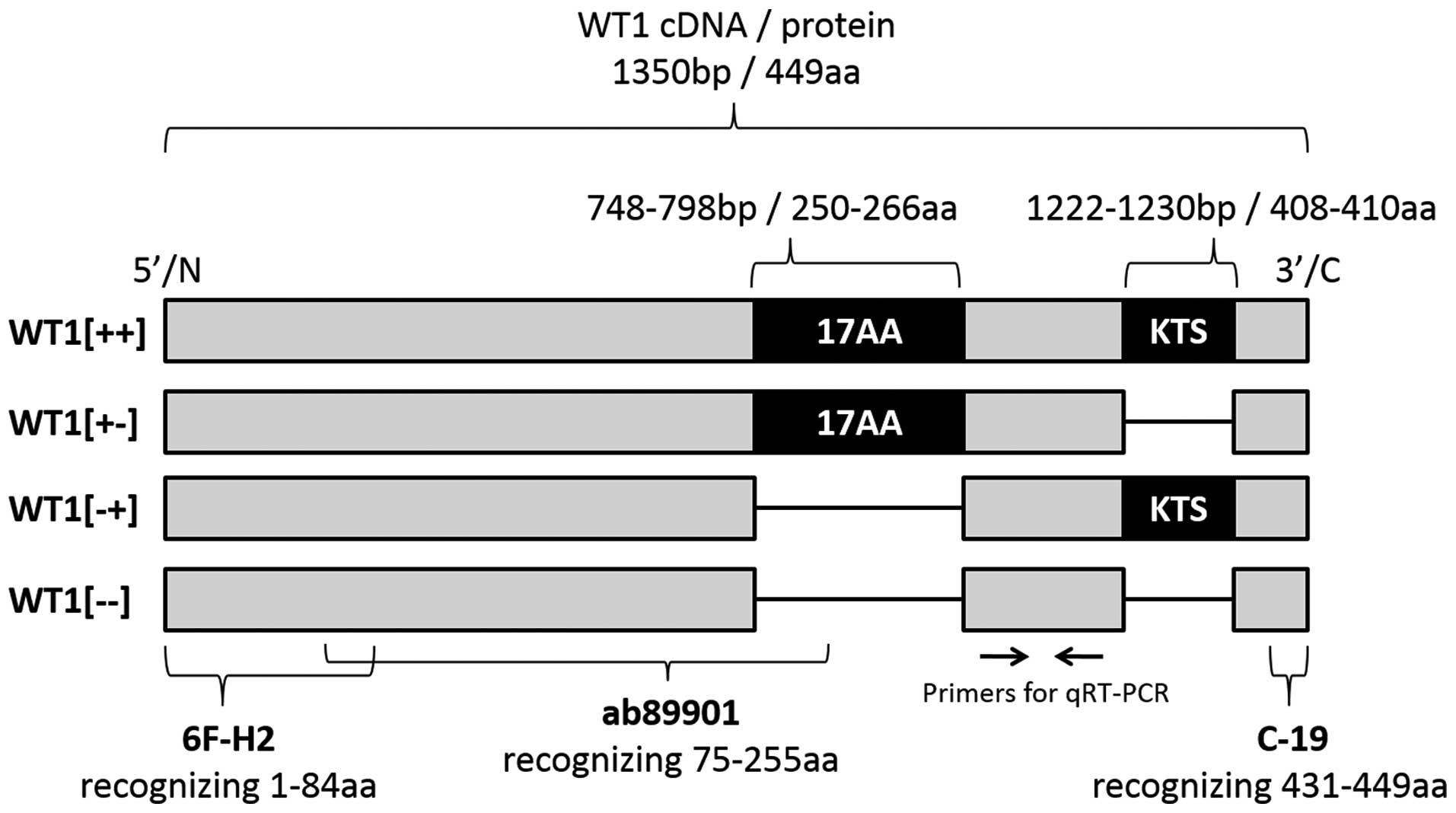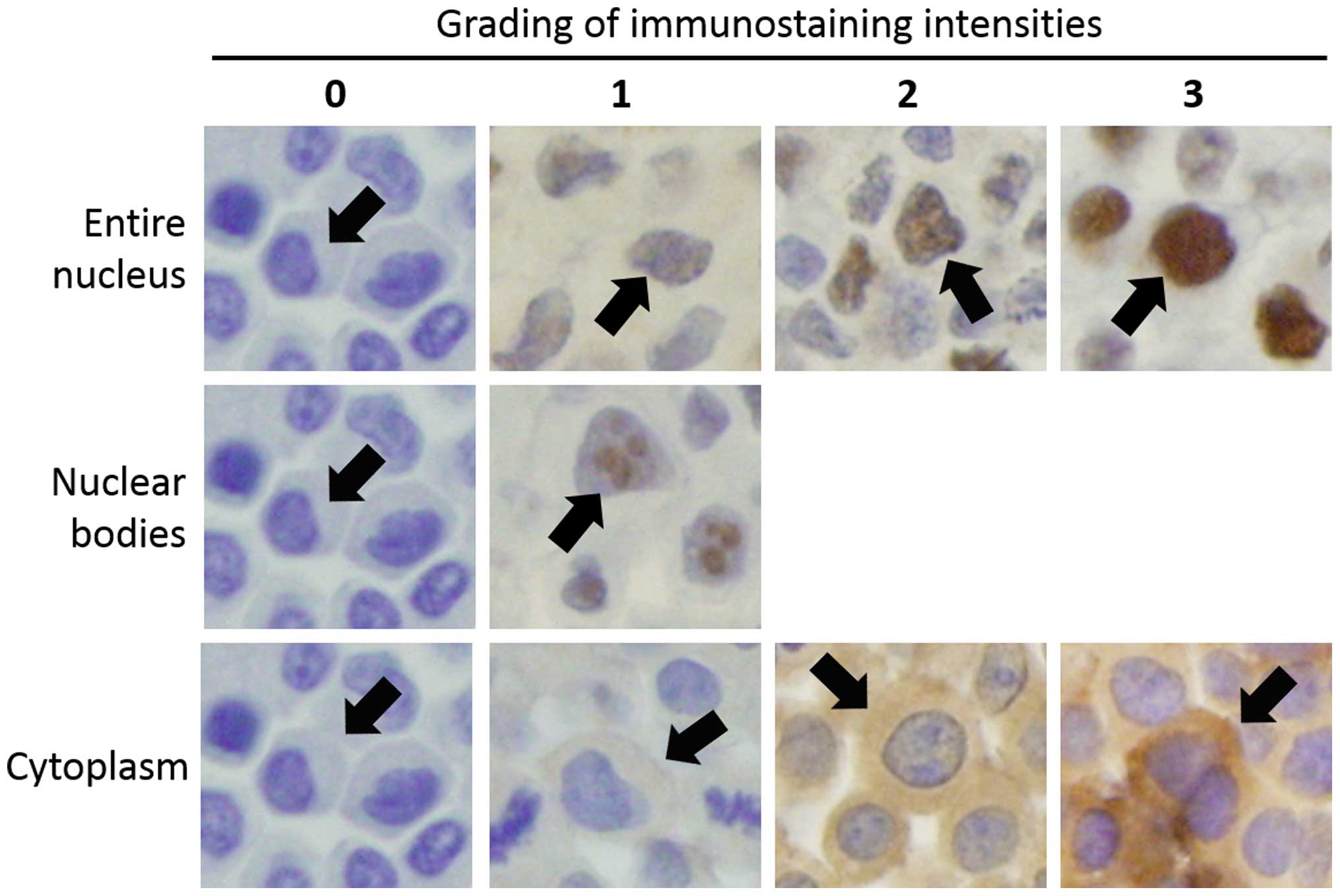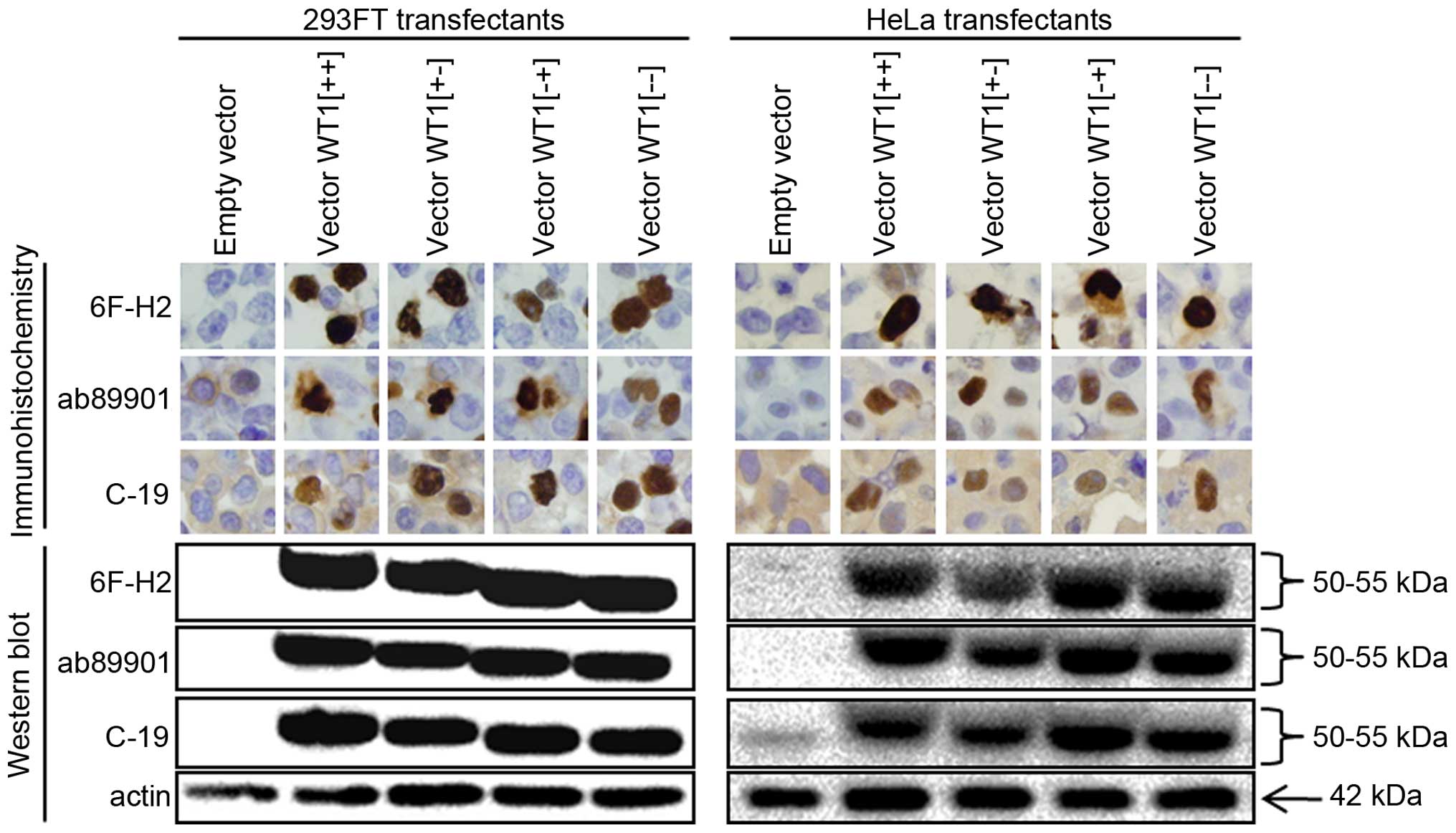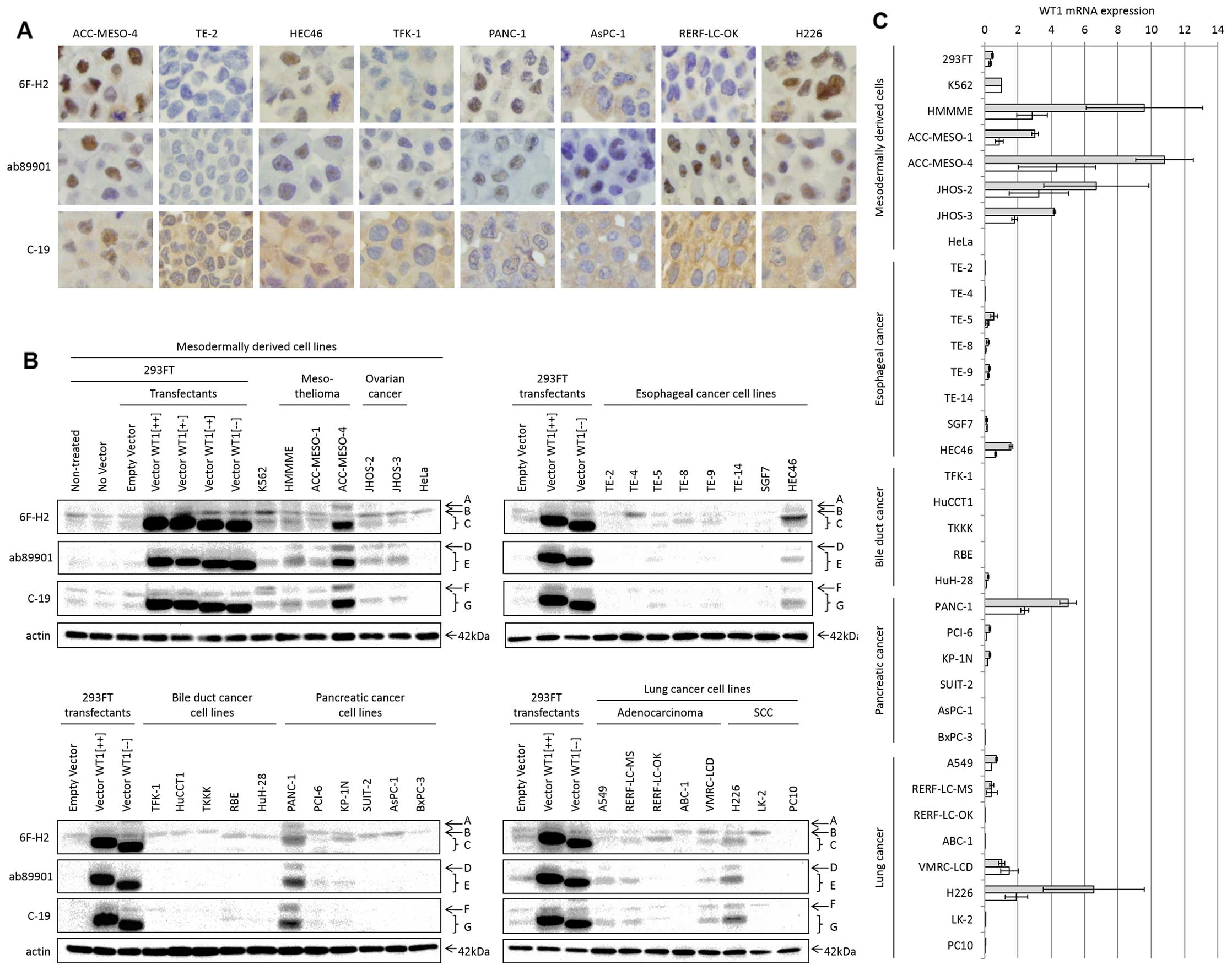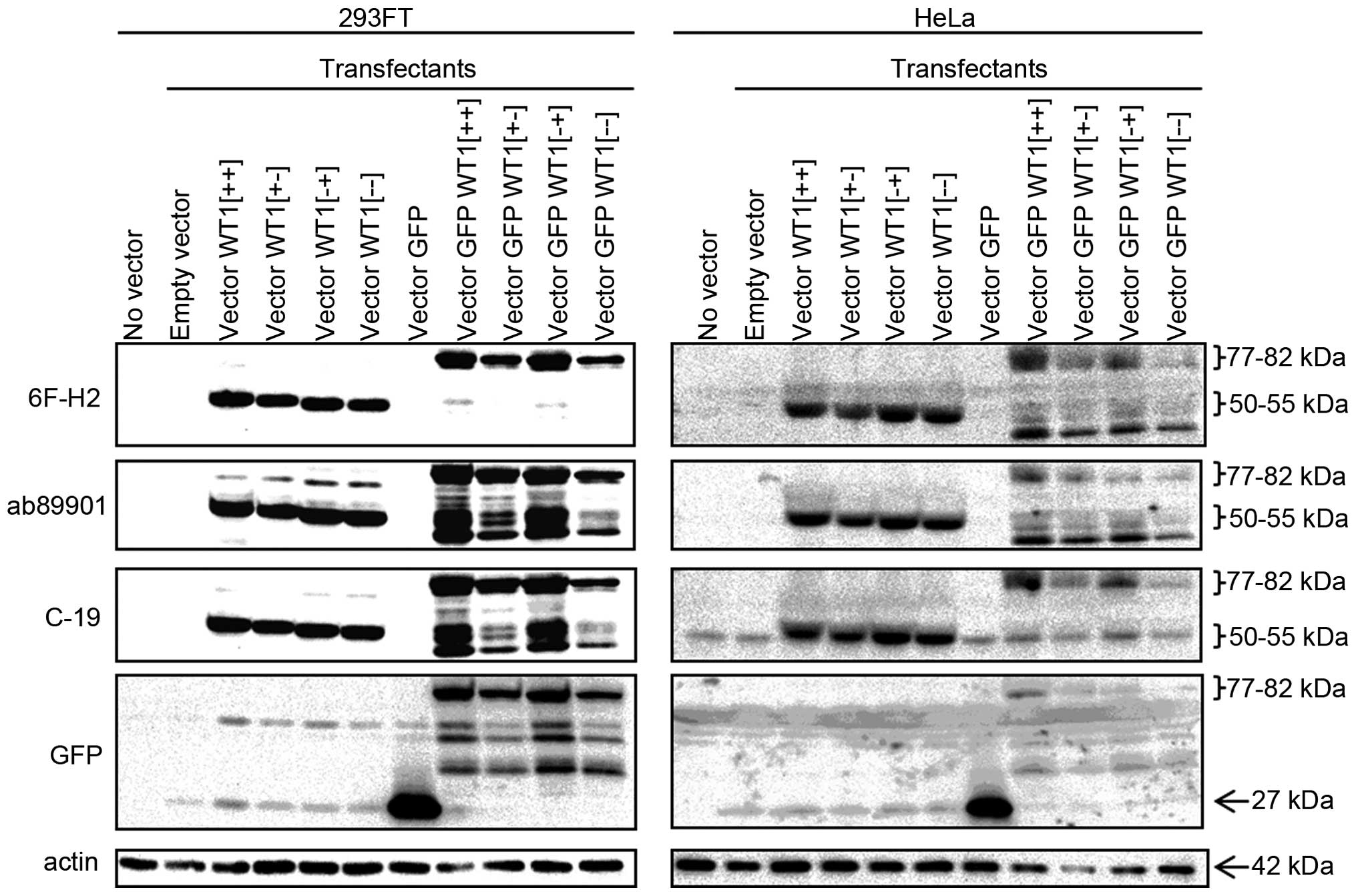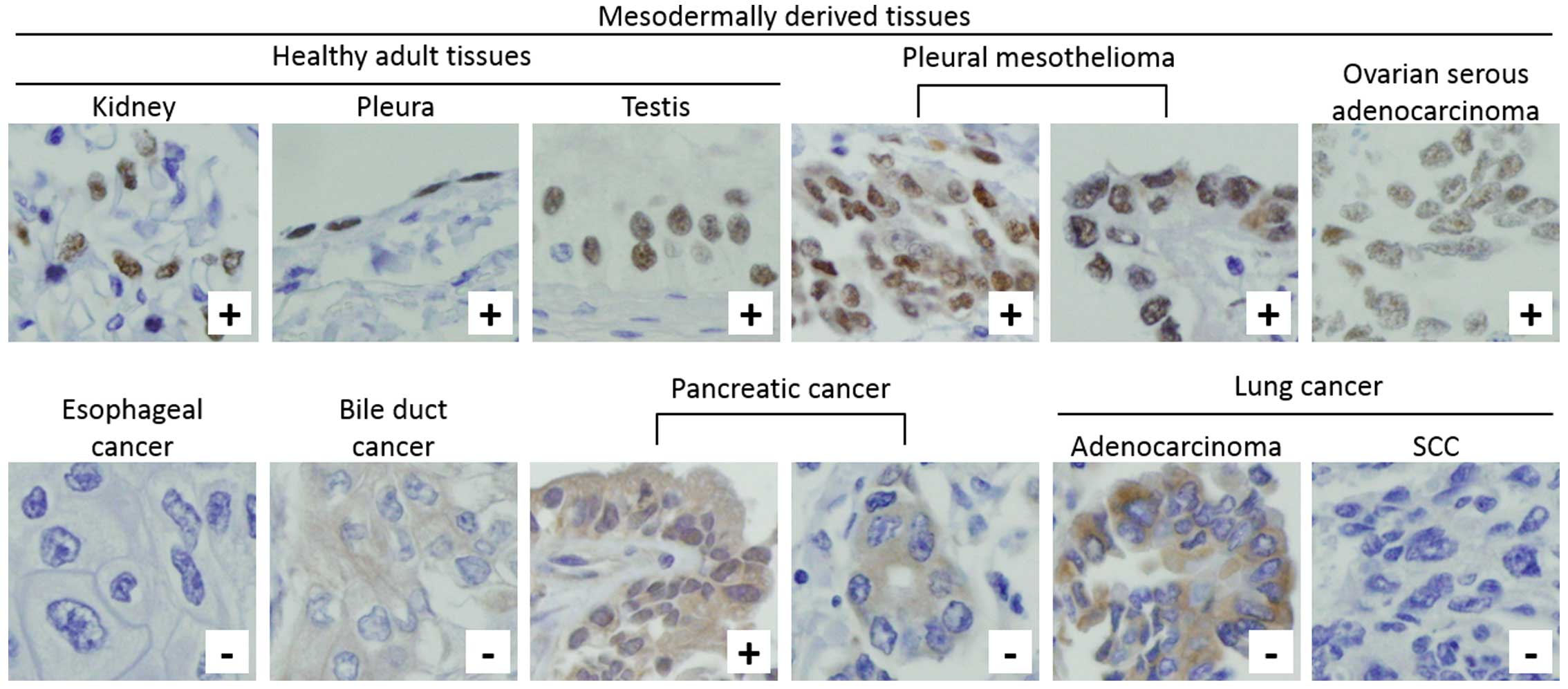|
1
|
Call KM, Glaser T, Ito CY, Buckler AJ,
Pelletier J, Haber DA, Rose EA, Kral A, Yeger H, Lewis WH, et al:
Isolation and characterization of a zinc finger polypeptide gene at
the human chromosome 11 Wilms' tumor locus. Cell. 60:509–520. 1990.
View Article : Google Scholar : PubMed/NCBI
|
|
2
|
Gessler M, Poustka A, Cavenee W, Neve RL,
Orkin SH and Bruns GA: Homozygous deletion in Wilms tumours of a
zinc-finger gene identified by chromosome jumping. Nature.
343:774–778. 1990. View
Article : Google Scholar : PubMed/NCBI
|
|
3
|
Pritchard-Jones K, Fleming S, Davidson D,
Bickmore W, Porteous D, Gosden C, Bard J, Buckler A, Pelletier J,
Housman D, et al: The candidate Wilms' tumour gene is involved in
genitourinary development. Nature. 346:194–197. 1990. View Article : Google Scholar : PubMed/NCBI
|
|
4
|
Mundlos S, Pelletier J, Darveau A,
Bachmann M, Winterpacht A and Zabel B: Nuclear localization of the
protein encoded by the Wilms' tumor gene WT1 in embryonic and adult
tissues. Development. 119:1329–1341. 1993.PubMed/NCBI
|
|
5
|
Larsson SH, Charlieu JP, Miyagawa K,
Engelkamp D, Rassoulzadegan M, Ross A, Cuzin F, van Heyningen V and
Hastie ND: Subnuclear localization of WT1 in splicing or
transcription factor domains is regulated by alternative splicing.
Cell. 81:391–401. 1995. View Article : Google Scholar : PubMed/NCBI
|
|
6
|
Menssen HD, Renkl HJ, Rodeck U, Maurer J,
Notter M, Schwartz S, Reinhardt R and Thiel E: Presence of Wilms'
tumor gene (wt1) transcripts and the WT1 nuclear protein in the
majority of human acute leukemias. Leukemia. 9:1060–1067.
1995.PubMed/NCBI
|
|
7
|
Miwa H, Beran M and Saunders GF:
Expression of the Wilms' tumor gene (WT1) in human leukemias.
Leukemia. 6:405–409. 1992.PubMed/NCBI
|
|
8
|
Amin KM, Litzky LA, Smythe WR, Mooney AM,
Morris JM, Mews DJ, Pass HI, Kari C, Rodeck U, Rauscher FJ III, et
al: Wilms' tumor 1 susceptibility (WT1) gene products are
selectively expressed in malignant mesothelioma. Am J Pathol.
146:344–356. 1995.PubMed/NCBI
|
|
9
|
Kumar-Singh S, Segers K, Rodeck U,
Backhovens H, Bogers J, Weyler J, Van Broeckhoven C and Van Marck
E: WT1 mutation in malignant mesothelioma and WT1 immunoreactivity
in relation to p53 and growth factor receptor expression, cell-type
transition, and prognosis. J Pathol. 181:67–74. 1997. View Article : Google Scholar : PubMed/NCBI
|
|
10
|
Oates J and Edwards C: HBME-1, MOC-31, WT1
and calretinin: An assessment of recently described markers for
mesothelioma and adenocarcinoma. Histopathology. 36:341–347. 2000.
View Article : Google Scholar : PubMed/NCBI
|
|
11
|
Ordóñez NG: Value of thyroid transcription
factor-1, E-cadherin, BG8, WT1, and CD44S immunostaining in
distinguishing epithelial pleural mesothelioma from pulmonary and
nonpulmonary adenocarcinoma. Am J Surg Pathol. 24:598–606. 2000.
View Article : Google Scholar : PubMed/NCBI
|
|
12
|
Foster MR, Johnson JE, Olson SJ and Allred
DC: Immunohistochemical analysis of nuclear versus cytoplasmic
staining of WT1 in malignant mesotheliomas and primary pulmonary
adenocarcinomas. Arch Pathol Lab Med. 125:1316–1320.
2001.PubMed/NCBI
|
|
13
|
Hecht JL, Lee BH, Pinkus JL and Pinkus GS:
The value of Wilms tumor susceptibility gene 1 in cytologic
preparations as a marker for malignant mesothelioma. Cancer.
96:105–109. 2002. View Article : Google Scholar : PubMed/NCBI
|
|
14
|
Tsuta K, Kato Y, Tochigi N, Hoshino T,
Takeda Y, Hosako M, Maeshima AM, Asamura H, Kondo T and Matsuno Y:
Comparison of different clones (WT49 versus 6F-H2) of WT-1
antibodies for immunohistochemical diagnosis of malignant pleural
mesothelioma. Appl Immunohistochem Mol Morphol. 17:126–130. 2009.
View Article : Google Scholar : PubMed/NCBI
|
|
15
|
Hwang H, Quenneville L, Yaziji H and Gown
AM: Wilms tumor gene product: Sensitive and contextually specific
marker of serous carcinomas of ovarian surface epithelial origin.
Appl Immunohistochem Mol Morphol. 12:122–126. 2004. View Article : Google Scholar : PubMed/NCBI
|
|
16
|
Han L, Pansare V, Al-Abbadi M, Husain M
and Feng J: Combination of MUC5ac and WT-1 immunohistochemistry is
useful in distinguishing pancreatic ductal carcinoma from ovarian
serous carcinoma in effusion cytology. Diagn Cytopathol.
38:333–336. 2010.
|
|
17
|
Cheever MA, Allison JP, Ferris AS, Finn
OJ, Hastings BM, Hecht TT, Mellman I, Prindiville SA, Viner JL,
Weiner LM, et al: The prioritization of cancer antigens: A National
Cancer Institute pilot project for the acceleration of
translational research. Clin Cancer Res. 15:5323–5337. 2009.
View Article : Google Scholar : PubMed/NCBI
|
|
18
|
Oji Y, Yano M, Nakano Y, Abeno S,
Nakatsuka S, Ikeba A, Yasuda T, Fujiwara Y, Takiguchi S, Yamamoto
H, et al: Overexpression of the Wilms' tumor gene WT1 in esophageal
cancer. Anticancer Res. 24(5B): 3103–3108. 2004.PubMed/NCBI
|
|
19
|
Nakatsuka S, Oji Y, Horiuchi T, Kanda T,
Kitagawa M, Takeuchi T, Kawano K, Kuwae Y, Yamauchi A, Okumura M,
et al: Immunohistochemical detection of WT1 protein in a variety of
cancer cells. Mod Pathol. 19:804–814. 2006.PubMed/NCBI
|
|
20
|
Oji Y, Yamamoto H, Nomura M, Nakano Y,
Ikeba A, Nakatsuka S, Abeno S, Kiyotoh E, Jomgeow T, Sekimoto M, et
al: Overexpression of the Wilms' tumor gene WT1 in colorectal
adenocarcinoma. Cancer Sci. 94:712–717. 2003. View Article : Google Scholar : PubMed/NCBI
|
|
21
|
Sera T, Hiasa Y, Mashiba T, Tokumoto Y,
Hirooka M, Konishi I, Matsuura B, Michitaka K, Udaka K and Onji M:
Wilms' tumour 1 gene expression is increased in hepatocellular
carcinoma and associated with poor prognosis. Eur J Cancer.
44:600–608. 2008. View Article : Google Scholar : PubMed/NCBI
|
|
22
|
Oji Y, Nakamori S, Fujikawa M, Nakatsuka
S, Yokota A, Tatsumi N, Abeno S, Ikeba A, Takashima S, Tsujie M, et
al: Overexpression of the Wilms' tumor gene WT1 in pancreatic
ductal adenocarcinoma. Cancer Sci. 95:583–587. 2004. View Article : Google Scholar : PubMed/NCBI
|
|
23
|
Oji Y, Miyoshi Y, Koga S, Nakano Y, Ando
A, Nakatsuka S, Ikeba A, Takahashi E, Sakaguchi N, Yokota A, et al:
Overexpression of the Wilms' tumor gene WT1 in primary thyroid
cancer. Cancer Sci. 94:606–611. 2003. View Article : Google Scholar : PubMed/NCBI
|
|
24
|
Oji Y, Miyoshi S, Maeda H, Hayashi S,
Tamaki H, Nakatsuka S, Yao M, Takahashi E, Nakano Y, Hirabayashi H,
et al: Overexpression of the Wilms' tumor gene WT1 in de novo lung
cancers. Int J Cancer. 100:297–303. 2002. View Article : Google Scholar : PubMed/NCBI
|
|
25
|
Loeb DM, Evron E, Patel CB, Sharma PM,
Niranjan B, Buluwela L, Weitzman SA, Korz D and Sukumar S: Wilms'
tumor suppressor gene (WT1) is expressed in primary breast tumors
despite tumor-specific promoter methylation. Cancer Res.
61:921–925. 2001.PubMed/NCBI
|
|
26
|
Miyoshi Y, Ando A, Egawa C, Taguchi T,
Tamaki Y, Tamaki H, Sugiyama H and Noguchi S: High expression of
Wilms' tumor suppressor gene predicts poor prognosis in breast
cancer patients. Clin Cancer Res. 8:1167–1171. 2002.PubMed/NCBI
|
|
27
|
Lee AH, Paish EC, Marchio C, Sapino A,
Schmitt FC, Ellis IO and Reis-Filho JS: The expression of Wilms'
tumour-1 and Ca125 in invasive micropapillary carcinoma of the
breast. Histopathology. 51:824–828. 2007. View Article : Google Scholar : PubMed/NCBI
|
|
28
|
Oji Y, Suzuki T, Nakano Y, Maruno M,
Nakatsuka S, Jomgeow T, Abeno S, Tatsumi N, Yokota A, Aoyagi S, et
al: Overexpression of the Wilms' tumor gene W T1 in primary
astrocytic tumors. Cancer Sci. 95:822–827. 2004. View Article : Google Scholar : PubMed/NCBI
|
|
29
|
Oka Y, Tsuboi A, Taguchi T, Osaki T, Kyo
T, Nakajima H, Elisseeva OA, Oji Y, Kawakami M, Ikegame K, et al:
Induction of WT1 (Wilms' tumor gene)-specific cytotoxic T
lymphocytes by WT1 peptide vaccine and the resultant cancer
regression. Proc Natl Acad Sci USA. 101:13885–13890. 2004.
View Article : Google Scholar : PubMed/NCBI
|
|
30
|
Morita S, Oka Y, Tsuboi A, Kawakami M,
Maruno M, Izumoto S, Osaki T, Taguchi T, Ueda T, Myoui A, et al: A
phase I/II trial of a WT1 (Wilms' tumor gene) peptide vaccine in
patients with solid malignancy: Safety assessment based on the
phase I data. Jpn J Clin Oncol. 36:231–236. 2006. View Article : Google Scholar : PubMed/NCBI
|
|
31
|
Izumoto S, Tsuboi A, Oka Y, Suzuki T,
Hashiba T, Kagawa N, Hashimoto N, Maruno M, Elisseeva OA, Shirakata
T, et al: Phase II clinical trial of Wilms tumor 1 peptide
vaccination for patients with recurrent glioblastoma multiforme. J
Neurosurg. 108:963–971. 2008. View Article : Google Scholar : PubMed/NCBI
|
|
32
|
Keilholz U, Letsch A, Busse A, Asemissen
AM, Bauer S, Blau IW, Hofmann WK, Uharek L, Thiel E and
Scheibenbogen C: A clinical and immunologic phase 2 trial of Wilms
tumor gene product 1 (WT1) peptide vaccination in patients with AML
and MDS. Blood. 113:6541–6548. 2009. View Article : Google Scholar : PubMed/NCBI
|
|
33
|
Ohno S, Kyo S, Myojo S, Dohi S, Ishizaki
J, Miyamoto K, Morita S, Sakamoto J, Enomoto T, Kimura T, et al:
Wilms' tumor 1 (WT1) peptide immunotherapy for gynecological
malignancy. Anticancer Res. 29:4779–4784. 2009.PubMed/NCBI
|
|
34
|
Van Tendeloo VF, Van de Velde A, Van
Driessche A, Cools N, Anguille S, Ladell K, Gostick E, Vermeulen K,
Pieters K, Nijs G, et al: Induction of complete and molecular
remissions in acute myeloid leukemia by Wilms' tumor 1
antigen-targeted dendritic cell vaccination. Proc Natl Acad Sci
USA. 107:13824–13829. 2010. View Article : Google Scholar : PubMed/NCBI
|
|
35
|
Krug LM, Dao T, Brown AB, Maslak P, Travis
W, Bekele S, Korontsvit T, Zakhaleva V, Wolchok J, Yuan J, et al:
WT1 peptide vaccinations induce CD4 and CD8 T cell immune responses
in patients with mesothelioma and non-small cell lung cancer.
Cancer Immunol Immunother. 59:1467–1479. 2010. View Article : Google Scholar : PubMed/NCBI
|
|
36
|
Kaida M, Morita-Hoshi Y, Soeda A, Wakeda
T, Yamaki Y, Kojima Y, Ueno H, Kondo S, Morizane C, Ikeda M, et al:
Phase 1 trial of Wilms tumor 1 (WT1) peptide vaccine and
gemcitabine combination therapy in patients with advanced
pancreatic or biliary tract cancer. J Immunother. 34:92–99. 2011.
View Article : Google Scholar
|
|
37
|
Usami N, Fukui T, Kondo M, Taniguchi T,
Yokoyama T, Mori S, Yokoi K, Horio Y, Shimokata K, Sekido Y, et al:
Establishment and characterization of four malignant pleural
mesothelioma cell lines from Japanese patients. Cancer Sci.
97:387–394. 2006. View Article : Google Scholar : PubMed/NCBI
|
|
38
|
Nishihira T, Hashimoto Y, Katayama M, Mori
S and Kuroki T: Molecular and cellular features of esophageal
cancer cells. J Cancer Res Clin Oncol. 119:441–449. 1993.
View Article : Google Scholar : PubMed/NCBI
|
|
39
|
Saito T, Kato H, Saito M, Karaki Y, Tazawa
K and Fujimaki M: TNF receptor number-dependent cytotoxicity to
TNF-resistant human esophageal cancer cell lines by combination
with recombinant human necrosis factor and hyperthermia. Hum Cell.
7:55–61. 1994.PubMed/NCBI
|
|
40
|
Yanagihara K, Ito A, Toge T and Numoto M:
Antiproliferative effects of isoflavones on human cancer cell lines
established from the gastrointestinal tract. Cancer Res.
53:5815–5821. 1993.PubMed/NCBI
|
|
41
|
Sugiura H, Ishikura H, Omi M, Kaji M, Iwai
K, Kishimoto T, Takahashi T, Kimura C, Kato H and Yoshiki T:
Lymphokine-activated killer cytotoxicity against pancreas
adenocarcinoma cell lines and vascular endothelial cells. Pathol
Int. 44:688–696. 1994. View Article : Google Scholar : PubMed/NCBI
|
|
42
|
Gerlinger M, Rowan AJ, Horswell S, Larkin
J, Endesfelder D, Gronroos E, Martinez P, Matthews N, Stewart A,
Tarpey P, et al: Intratumor heterogeneity and branched evolution
revealed by multiregion sequencing. N Engl J Med. 366:883–892.
2012. View Article : Google Scholar : PubMed/NCBI
|



